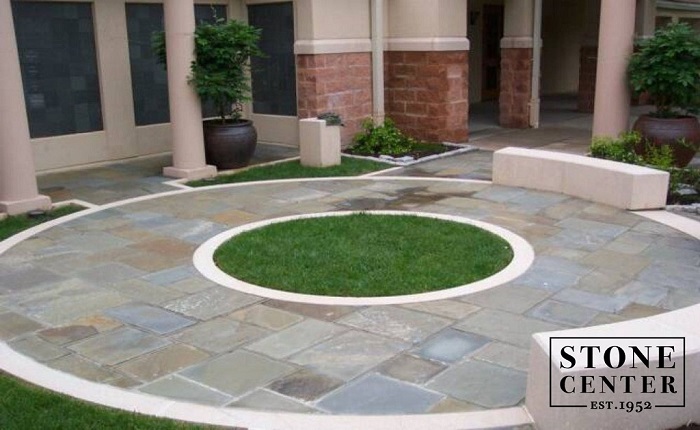Bluestone: Uses, Types, and Benefits in Construction and Landscaping”

Bluestone is a widely used natural stone in construction and landscaping projects, appreciated for its durability, color variations, and aesthetic appeal. The term “bluestone” generally refers to various types of sedimentary and igneous rocks that share a blue-gray hue. This stone can be used in a variety of applications, including patios, walkways, steps, and decorative features.
This blog post delves into the different types of bluestone, its many uses, benefits, and maintenance tips, along with answers to some frequently asked questions. Let’s explore what makes bluestone a popular choice for architects, builders, and homeowners.
What is Bluestone?
Bluestone is a type of natural stone that features a distinctive blue-gray color. While the term “bluestone” is used broadly, it can refer to several different types of rock, each with its unique composition and characteristics. Most commonly, bluestone is either sandstone or limestone.
The name originates from the bluish appearance of the stone, though some varieties may have shades of green, brown, or even purple. Bluestone’s appearance can vary significantly based on its region of origin, mineral composition, and how it has been processed.
Types of Bluestone
There are two primary types of bluestone used in the market today:
- Pennsylvania Bluestone: This type of bluestone is a sandstone found mainly in Pennsylvania and New York. It is a sedimentary rock formed from sand-sized grains bound together over time. The colors range from blue to gray to even tan, depending on the quarry.
- Australian Bluestone (Basalt): In Australia, the term bluestone refers to a type of basalt, a volcanic rock. This type is more robust and dense compared to Pennsylvania bluestone and has a darker color, often with a more uniform appearance. It is widely used in paving and as a building stone.
Disadvantages of Bluestone
While bluestone has numerous benefits, there are a few potential drawbacks to consider:
Cost: Bluestone can be more expensive than other types of stone or concrete.
Color Fading: Over time, exposure to sunlight may cause the color to fade slightly.
Weight: The stone is quite heavy, making it more challenging to install and transport.
Bluestone Finishes: Thermal vs. Natural Cleft
Bluestone is available in different finishes, each suited for particular applications:
- Thermal Finish: This finish is achieved by applying intense heat to the stone, giving it a consistent texture. It is ideal for surfaces like patios and walkways.
- Natural Cleft: The natural cleft finish preserves the stone’s original texture, with a more rugged and uneven surface. This finish is used in areas where a more rustic look is desired.
Installation Considerations for Bluestone Projects
Before installing bluestone, several factors should be considered to ensure a successful project:
Base Preparation: Proper base preparation is crucial for ensuring the stability and longevity of bluestone installations.
Joint Material: The choice of joint material can affect the appearance and functionality of a bluestone project. Common options include sand, mortar, and polymeric jointing sand.
Sealing: Sealing bluestone can help protect it from staining and weathering, especially in high-traffic areas.
Caring for Bluestone
To keep bluestone looking its best, proper maintenance is essential:
Cleaning: Regular sweeping and rinsing with water can help keep dirt and debris from accumulating.
Sealing: While not always necessary, sealing can help protect the stone from staining and weather damage.
Stain Removal: For stains, a mixture of water and mild soap usually works. For tougher stains, stone-specific cleaners may be required.
Where to Buy Bluestone and How to Choose the Right Supplier
When purchasing bluestone, consider factors like the quality of the stone, the supplier’s reputation, and the cost:
- Research Online Reviews: Check customer reviews and ratings for insights on quality and service.
- Visit the Supplier: If possible, visit the supplier’s showroom or quarry to inspect the stone in person.
- Get Multiple Quotes: Comparing quotes from different suppliers can help ensure you get the best deal.
Conclusion
Bluestone is a valuable and versatile material with a wide range of applications in construction and landscaping. It provides a blend of durability, natural beauty, and functionality, making it a preferred choice for homeowners, builders, and architects. While the cost and maintenance requirements may be higher than some other materials, the benefits of using bluestone often outweigh the downsides. With proper care, this natural stone can last for decades, adding both aesthetic and functional value to any project.
FAQs
1. What is the difference between Pennsylvania bluestone and Australian bluestone?
Pennsylvania bluestone is a type of sandstone, while Australian bluestone is basalt, a volcanic rock. The former is lighter in color, while the latter is darker and more robust.
2. How much does bluestone cost?
The cost of bluestone varies depending on factors like the type, finish, and region. On average, it can range from $20 to $40 per square foot.
3. Can I install bluestone myself?
While it’s possible to install bluestone yourself, it’s recommended to hire professionals, especially for large projects or areas requiring a level base.
4. Does bluestone need to be sealed?
Sealing is optional but recommended for areas exposed to heavy use or staining agents. It can enhance the stone’s longevity and appearance.
5. Can bluestone withstand freezing temperatures?
Yes, bluestone is frost-resistant and can withstand freezing temperatures, making it suitable for use in colder climates.





